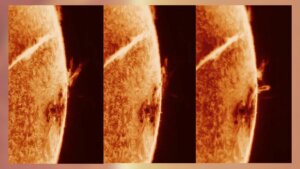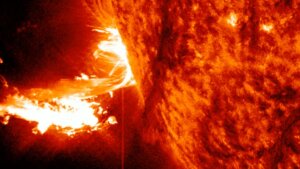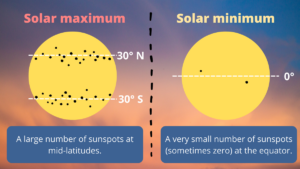The Sun is not a quiet star. It sustains life on Earth, but it risks it too. Recently the Earth was disrupted by huge sunspots.

Sunspots
According to Wikipedia:
Sunspots are temporary spots on the Sun’s surface that are darker than the surrounding area… Indicating intense magnetic activity, sunspots accompany other active region phenomena such as coronal loops, prominences, and reconnection events. Most solar flares and coronal mass ejections originate in these magnetically active regions around visible sunspot groupings.
A very large and active sunspot pointed our way recently and caused the aurora borealis to be seen over a much wider expanse than usual. But it also interfered with radio signals. I follow Space.com and they have produced many articles following events and explaining them. Here are just a few:
Plasma from a powerful solar eruption called a coronal mass ejection (CME) slammed into Earth on Friday (May 10), sparking an intense geomagnetic storm.
This storm was so intense that the U.S. National Oceanic and Atmospheric Administration, which forecasts solar storms and their impact on our planet, issued a storm warning for the first time in nearly two decades.
Astrophotographer Andrew McCarthy has been keeping a watchful eye on sunspot AR3697 as it appears over the sun‘s southeastern limb. The incredible footage, captured from his backyard in Arizona showcases the turbulent nature of the sunspot region in great detail.

Image-credit-Andrew-McCarthy-Image-cropped-in-Canva-by-Daisy-Dobrijevic
Aurora Borealis

Image-credit-Sarah-Histand
The NASA Science website for children, Space Place, explains this very well:
The Sun sends us more than heat and light; it sends lots of other energy and small particles our way. The protective magnetic field around Earth shields us from most of the energy and particles, and we don’t even notice them.
But the Sun doesn’t send the same amount of energy all the time. There is a constant streaming solar wind and there are also solar storms. During one kind of solar storm called a coronal mass ejection, the Sun burps out a huge bubble of electrified gas that can travel through space at high speeds.
When a solar storm comes toward us, some of the energy and small particles can travel down the magnetic field lines at the north and south poles into Earth’s atmosphere.
There, the particles interact with gases in our atmosphere resulting in beautiful displays of light in the sky. Oxygen gives off green and red light. Nitrogen glows blue and purple.
Radio Signals
The light from any solar flares in this window will reach Earth, with the potential to produce short-term radio blackouts.
Coming Round Again
The sun spins, it takes 27 Earth days for it to complete one revolution. So a dangerous sunspot will reappear.

Image-credit-NASA-SDO-and-the-AIA-EVE-and-HMI-science-teams-helioviewer.org
On Monday (June 10), Region 3697 fired off an even stronger solar flare, a X1.5-class at 7:08 a.m. EST (1108 GMT). Parts of Earth’s sunlit side could experience temporary or complete loss of high frequency (HF) radio signals.
Reversal of the Poles

Image-Credit-Future
As if that wasn’t enough, the sun goes through an eleven year cycle. As the sunspots and activity gets worse, it disrupts the sun’s magnetic poles, leading to a flip between north and south. Scientists say there is nothing to fear(!)
 Ann Marie Thomas is the author of five medieval history books, a surprisingly cheerful poetry collection about her 2010 stroke, and the science fiction series Flight of the Kestrel, Intruders, Alien Secrets & Crisis of Conscience are out now Follow her at http://eepurl.com/bbOsyz
Ann Marie Thomas is the author of five medieval history books, a surprisingly cheerful poetry collection about her 2010 stroke, and the science fiction series Flight of the Kestrel, Intruders, Alien Secrets & Crisis of Conscience are out now Follow her at http://eepurl.com/bbOsyz